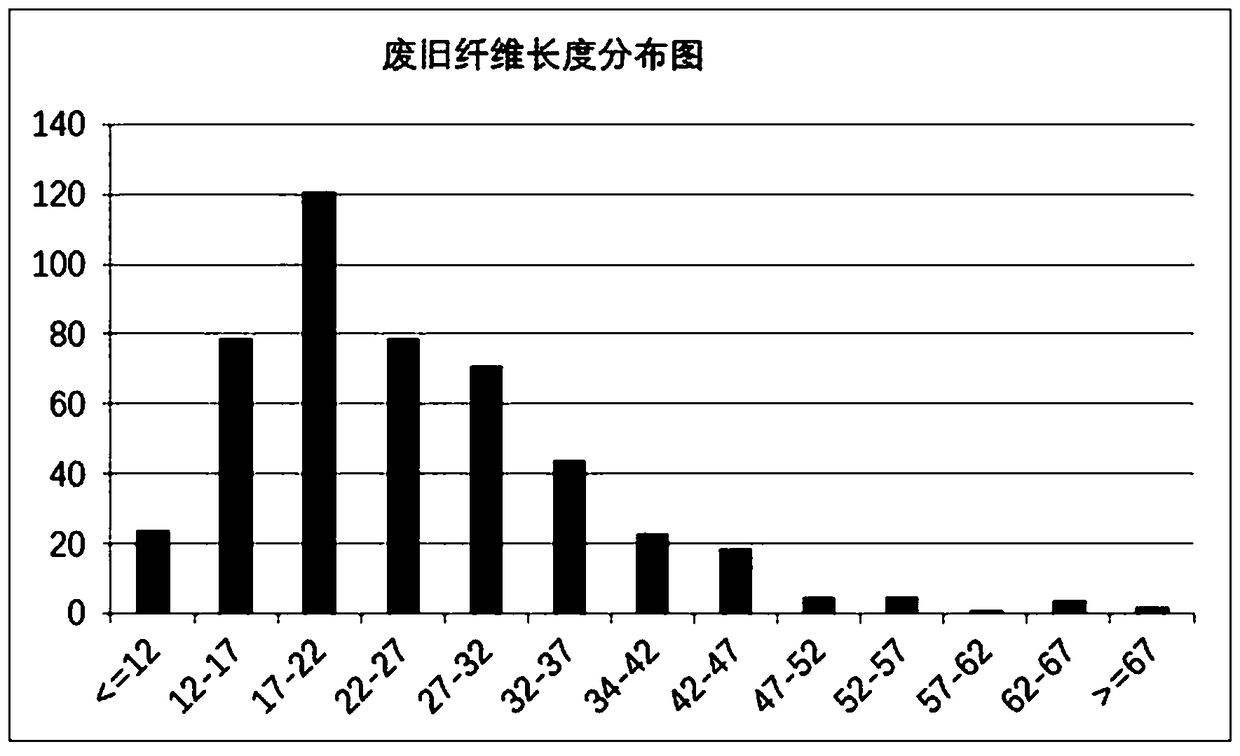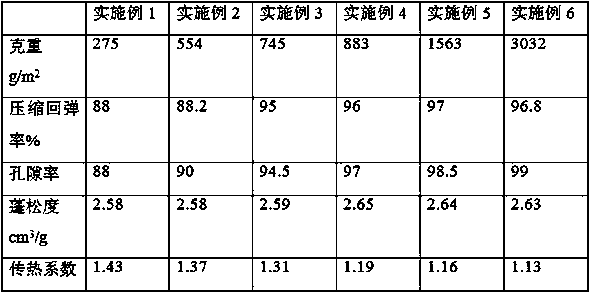Heat insulation elastic non-woven material manufactured by utilizing waste textile fibers and preparation method thereof
A technology of non-woven materials and textile fibers, applied in non-woven fabrics, textiles, papermaking, fiber processing, etc., can solve problems such as unstable fiber structures, and achieve the effects of simple methods, hygienic guarantees, and low cost
- Summary
- Abstract
- Description
- Claims
- Application Information
AI Technical Summary
Problems solved by technology
Method used
Image
Examples
Embodiment 1
[0029] This embodiment provides a method for preparing thermal insulation elastic felt from waste textile fibers, comprising the following steps:
[0030] 1. Tear into pieces: send the waste textiles into two parallel three-knife cutting machines to form cloth pieces with a size of 5*15cm. The speed of the three-knife cutting machines is set at 150 stabs / min;
[0031] 2. Cracking into fibers: the cloth cut in step 1 is sent to the foreign fiber separator after two openings, to separate buttons and zippers, and then through two fine openings to loosen them into loose fibers to form a waste fiber mixture , set the speed of the rough opening structure to 350r / min; the preferred feature of the rough opening feeder is a saw-toothed opening structure supporting arc-shaped teeth, the inner angle of the optimal arc-shaped teeth is 75°, the axial tooth spacing is 3mm, and the circumference The pitch is 20mm.
[0032] 3. Packing: Feed the waste fiber mixture into the fiber baler, and w...
Embodiment 2
[0037] This embodiment provides a method for preparing thermal insulation elastic felt from waste textile fibers, comprising the following steps:
[0038] 1. Tear into pieces: Send the waste textiles to two parallel three-knife cutting machines to form cloth pieces of 5*10cm in size. The speed of the three-knife cutting machines is set at 195 stabs / min;
[0039]2. Cracking into fibers: the cloth cut in step 1 is sent to the foreign fiber separator after two openings, to separate buttons and zippers, and then through two fine openings to loosen them into loose fibers to form a waste fiber mixture , set the speed of the rough opening structure to 350r / min; the preferred feature of the rough opening feeder is a sawtooth opening structure with arc-shaped teeth, the inner angle of the optimal arc-shaped teeth is 95°, the axial tooth spacing is 6mm, and the circumference The vertical spacing is 36mm.
[0040] 3. Packing: Feed the waste fiber mixture into the fiber baler, and withst...
Embodiment 3
[0045] This embodiment provides a method for preparing thermal insulation elastic felt from waste textile fibers, comprising the following steps:
[0046] 1. Tear into pieces: send the waste textiles into two parallel three-knife cutting machines to form cloth pieces with a size of 15*15cm. The speed of the three-knife cutting machines is set at 160 stabs / min;
[0047] 2. Cracking into fibers: the cloth cut in step 1 is sent to the foreign fiber separator after two openings, to separate buttons and zippers, and then through two fine openings to loosen them into loose fibers to form a waste fiber mixture , set the speed of the coarse opening structure to 350r / min; the preferred internal angle of the arc-shaped teeth is 95°, the axial tooth spacing is 3mm, and the circumferential spacing is 36mm.
[0048] 3. Packing: Feed the waste fiber mixture into the fiber baler, and withstand the pressure of 40Mpa to form a bulk density of 390kg / m 3 The fiber package, the size of the fiber...
PUM
| Property | Measurement | Unit |
|---|---|---|
| density | aaaaa | aaaaa |
| depth | aaaaa | aaaaa |
| length | aaaaa | aaaaa |
Abstract
Description
Claims
Application Information
 Login to View More
Login to View More - R&D
- Intellectual Property
- Life Sciences
- Materials
- Tech Scout
- Unparalleled Data Quality
- Higher Quality Content
- 60% Fewer Hallucinations
Browse by: Latest US Patents, China's latest patents, Technical Efficacy Thesaurus, Application Domain, Technology Topic, Popular Technical Reports.
© 2025 PatSnap. All rights reserved.Legal|Privacy policy|Modern Slavery Act Transparency Statement|Sitemap|About US| Contact US: help@patsnap.com



